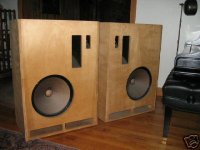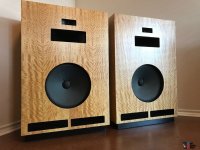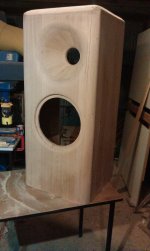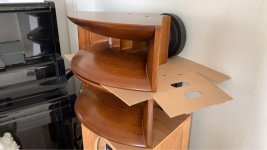A standard prosound box will mount a standard black horn externally onto a black baffle. Simple.
The examples pictured mount a standard black horn on the back of a nice timber baffle.
I think this is good, aesthetically, but these examples have a big sharp lip at the horn mouth, which seems like poor design acoustically.
Are there any similar builds - that mount the horn to the back of a nice baffle - but which have the baffle cutout angled to match the horn mouth angle?
I'm curious how this would look, and (if someone has done it) how they machined the cutout to get it to match up perfectly with the horn.
The examples pictured mount a standard black horn on the back of a nice timber baffle.
I think this is good, aesthetically, but these examples have a big sharp lip at the horn mouth, which seems like poor design acoustically.
Are there any similar builds - that mount the horn to the back of a nice baffle - but which have the baffle cutout angled to match the horn mouth angle?
I'm curious how this would look, and (if someone has done it) how they machined the cutout to get it to match up perfectly with the horn.
Attachments
There is no one correct way to do this as these profile combinations are unique (they have character). You could begin by trying to make it smooth.
Purely for aesthetics: to have more wood and less plastic on view.
e.g. I like the look of this previous build (pictured), and of laminated ply horns, such as the Yuichi style horns (pictured).
...but I'm not very good / patient / well equipped for making something like the latter; I tend to build things 95% correct, then use a lot of time + sandpaper to get the last 5% right.
For a conventional horn, this gets very fiddly and awkward towards the throat. Hence it would be easier to:
- stick a wood baffle in front of a premade horn
Or
- make the mouth part of the horn from wood, and use a some hacked or found or cast object as the throat section.
That previous build used a found object: a hacked Ikea bowl. Something like that, but to a much smaller throat, would be ideal.
The only existing example I know of that does this is the (crazy expensive) AH! / Cogent horn.
e.g. I like the look of this previous build (pictured), and of laminated ply horns, such as the Yuichi style horns (pictured).
...but I'm not very good / patient / well equipped for making something like the latter; I tend to build things 95% correct, then use a lot of time + sandpaper to get the last 5% right.
For a conventional horn, this gets very fiddly and awkward towards the throat. Hence it would be easier to:
- stick a wood baffle in front of a premade horn
Or
- make the mouth part of the horn from wood, and use a some hacked or found or cast object as the throat section.
That previous build used a found object: a hacked Ikea bowl. Something like that, but to a much smaller throat, would be ideal.
The only existing example I know of that does this is the (crazy expensive) AH! / Cogent horn.
Attachments
Last edited:
You could begin by trying to make it smooth.
...and that's the challenge.
e.g.
I use a plastic horn + a wood baffle.
I use a power tool (e.g. a 45 degree router bit) to get the the baffle cutout roughly correct.
I glue the horn on, then use hand tools / sandpaper to get the horn-to-baffle transition 100% smooth.
That will be fine acoustically, but aesthetically not as good as the examples in my 1st post: the plastic horn will be scratched up at the interface.
I just flush mount the horn in my projects.
Maybe consider trying to vinyl wrap the horn in wood effect vinyl ?
I've seen wood effect paint techniques on the web too.
Rob.
Maybe consider trying to vinyl wrap the horn in wood effect vinyl ?
I've seen wood effect paint techniques on the web too.
Rob.
The most critical part of these horns as they stand could possibly be the vertical near the middle. Look at the wooden Yuichis, imagine cutting them flat across to mount flush on a baffle, it's the middle top and bottom that are lost.. OK, those are radials and these are not, but anyway...
The problem with attending to the length, mouth size and diffraction characteristc is that you might end up with a reduction in directivity, or you might increase it. Therefore without knowing what you have, what you want and following the changes with measurements then..
The problem with attending to the length, mouth size and diffraction characteristc is that you might end up with a reduction in directivity, or you might increase it. Therefore without knowing what you have, what you want and following the changes with measurements then..
Yeah need to use modern simulation and manufacturing if you want to keep some performance and have it look good.
I also like the classic box shape aesthetically. Unfortunately only merit for such box is that it is relatively easy to build. For example those big faces on the post #1 have mucho other problems other than the horn mouth termination... loads of interference due to diffraction, ports are at worst position etc 😀 But, aesthetics has a big role in home audio so anything goes.
I also like the classic box shape aesthetically. Unfortunately only merit for such box is that it is relatively easy to build. For example those big faces on the post #1 have mucho other problems other than the horn mouth termination... loads of interference due to diffraction, ports are at worst position etc 😀 But, aesthetics has a big role in home audio so anything goes.
- Home
- Loudspeakers
- Multi-Way
- horn to baffle transition and aesthetics



